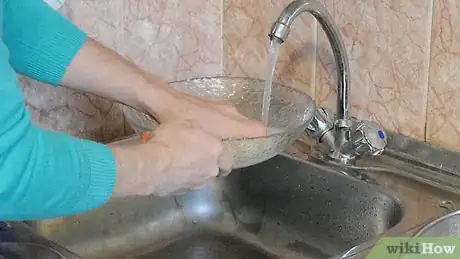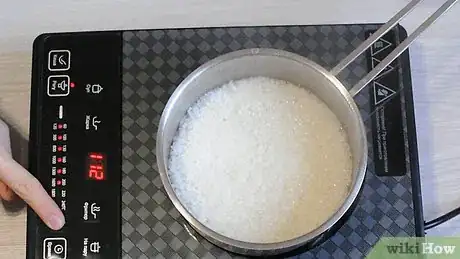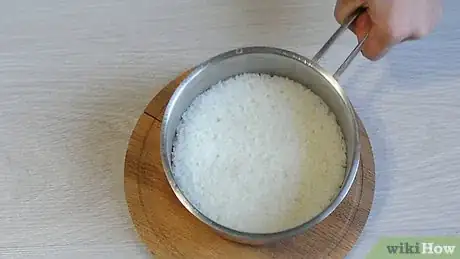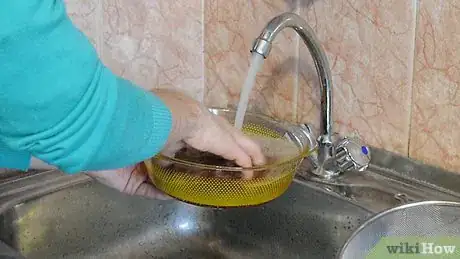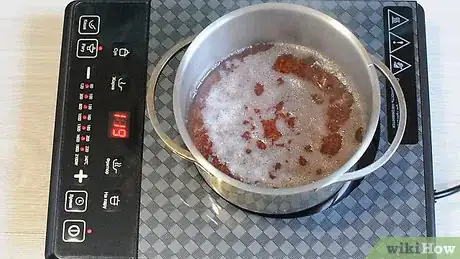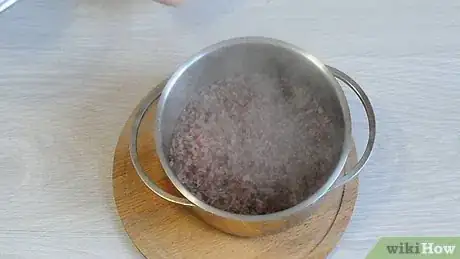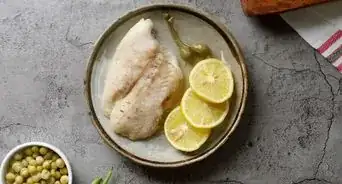This article was co-authored by Yoko Isassi and by wikiHow staff writer, Megaera Lorenz, PhD. Yoko Isassi is a Japanese Food Specialist and the Founder of Foodstory in Los Angeles, California. Since 2011, she has taught others how to cook Japanese food and educated others about Japanese food culture. Yoko holds an MA from Columbia University.
There are 8 references cited in this article, which can be found at the bottom of the page.
This article has been viewed 21,593 times.
Short grain rice is a staple of many Asian dishes, such as Japanese-style rice. It is starchier and stickier than long and medium grain varieties, and requires slightly different cooking techniques. Cooking short grain rice on the stove is relatively simple, but the correct procedure will depend on whether you are making white or brown rice.
Steps
Cooking Short Grain White Rice
-
1Rinse your rice until the water runs clear. Place the rice in a pot or large mixing bowl and run cool water into it. Swish the rice with your fingers, then pour off the water or drain the rice in a mesh strainer. The water will become cloudy and milky during rinsing. Repeat this process until the water stays clear.[1]
- You may need to rinse the rice 2-4 times to get all the starch off of it.
- After you've drained the rice, you may wish to gently rub the grains together between your hands. This can help give the grains a more polished texture.
- Short grain rice is very starchy, so rinsing can help prevent it from becoming too sticky or mushy during cooking.
-
2Soak the rice in cool water for at least 30 minutes. Once the rice is rinsed, place it in a pot with some cool water. Let the rice sit in the pot with the water for 30 minutes to 1 hour.[2]
- Soaking the rice can reduce cooking time, help the rice cook more evenly, and improve its texture.[3]
- Don't let the rice sit in the water for more than 8 hours, or it will become mushy and flavorless.
- You may find it easiest to soak the rice in the same water that you will use for cooking.
Advertisement -
3Use 1 cup (240 mL) and 2 tablespoons (30 mL) of water for every 1 cup (240 mL) of rice. Since the rice will cook by absorbing the water in the pot, it's important to use the right ratio of water to rice. If you wish, you can experiment with slightly increasing or reducing the amount of water if you want rice that is more or less moist.[4]
- Keep in mind that the rice may increase in volume by up to 3 or 4 times as you cook it.[5] Before you start cooking, decide how much cooked rice you want to end up with, and choose a pan that's big enough to contain it.
- It is best to cook rice in soft or purified water.
-
4Bring the rice and water to a boil in a large saucepan. Turn the burner on high. Observe the rice and water carefully as you wait. It should take about 3-5 minutes for the water to start boiling, although the time may vary depending on how much rice you are cooking and how strong your burner is.[6]
-
5Put a lid on the pot and allow the rice to boil for about 5 minutes. Once the water starts boiling, cover the pot with a tight-fitting lid right away. Let the rice cook on high for 1 minute, then reduce the heat to medium and let it continue to boil for another 4 to 5 minutes.[7]
- If you can, select a pot with a glass lid so that you can see the rice without opening the pot. Once the water level is low enough so that you can see the surface of the rice, it's time to turn the heat down to low.
-
6Reduce the heat to low for and let the rice simmer for 10 minutes. During this time, the rice will absorb the rest of the water in the pot. It's very important not to open the pot at this point, since that will let out moisture and may cause your rice to dry out too early or burn.[8]
- If you can't see the rice through the lid, listen for hissing or crackling sounds. These sounds indicate that most or all of the water has been absorbed.[9]
-
7Turn up the heat for a few seconds to absorb any remaining moisture. After the rice has simmered for 10 minutes, open the lid quickly to check if there is still any visible water in the pot. If there is, switch the burner to high for no more than 30 seconds to get rid of the extra water.[10]
-
8Remove the pot from the heat and let it sit for 10-15 minutes. Once the rice is done cooking, turn off the heat and place the pot on a cool burner or pot holder. Drape a cloth over the pot and let it sit and cool down. This will help the rice firm up and absorb any remaining moisture.[11]
- This step is essential for achieving a texture that is sticky without being mushy or watery.
- If you wish, you can gently stir or fluff the rice with a fork before serving.
Making Short Grain Brown Rice
-
1Soak your rice overnight if you want a faster cooking time. Brown rice is much slower to cook than white rice, but soaking your rice overnight can cut the cooking time almost in half.[12] Place your rice in a pot with 2 parts water for every 1 part rice, then cover the pot and put it in the refrigerator. Let the rice sit in the pot for at least 6 hours, or overnight.
- For example, if you're making 1 cup (240 mL) of rice, put it in the pot with 2 cups (470 mL) of water.
-
2Rinse the rice under cold water if you wish. If you'd like to rinse your rice, place it in a bowl or pot and run a little cold water into the container. Swish the rice around with your fingers or a spoon, then drain off the water, which should look cloudy when you are done.
- Rinsing can help remove the coating of bran dust and starch that is often found on short grain brown rice.[13]
-
3Use 2.5 cups (590 mL) of water or broth for every 1 cup (240 mL) of brown rice. Before you start cooking, think about how much rice you want to end up with. During the cooking process, the rice will absorb the liquid in the pot and will triple or quadruple in volume.[14]
- For example, you'll end up with 3 cups (710 mL) of cooked rice if you start with 1 cup (240 mL) of uncooked rice.
-
4Bring the rice and water or broth to a boil in a large pot. Use a large saucepan with a tight-fitting lid. Place the pot on a simmer burner and leave it uncovered, checking frequently until you see the water beginning to boil.[15]
- If you're using water instead of broth, add a pinch of salt for a little extra flavor if you wish.
- Make sure to select a pan that's large enough to contain the volume of rice you will end up with after cooking.
-
5Reduce the heat to low and cover the pot tightly. As soon as the water starts to boil, turn the heat down to bring it to a simmer. Close the lid well to prevent steam from escaping. The rice will cook by gradually absorbing the water in the pot.[16]
- Resist the urge to check on the rice frequently or stir it while it's cooking. This will just let out steam and may result in your rice drying out before it's done cooking.
-
6Allow the rice to simmer in the pot for 40 to 50 minutes. Brown rice takes a long time to cook, but times will vary depending on the size of your batch of rice and how you prepared it beforehand. If you didn't soak your rice before cooking it, start checking on it occasionally after about 30 minutes to make sure it's not burning or dried out.[17]
- If you soaked your rice before cooking it, it may be ready in as little as 20 minutes.[18]
- The rice is done when the water is absorbed and the rice is tender.
-
7Remove the pot from the heat and allow it to sit for 5 minutes. Once the rice is done, turn off the burner right away and move your pan to a cool burner or potholder. Leave the pot covered and give the rice a chance to cool down and get firm before serving.[19]
- Scooping the rice out of the pot before it's had a chance to cool down and firm up can cause the individual grains to break apart.
- After your rice has had a chance to sit, use a fork to fluff up and separate the grains.[20] This will allow any remaining excess moisture to evaporate from the rice.
Things You'll Need
- White or brown short grain rice
- Large saucepan with tight-fitting lid
- Strainer
- Water or broth
References
- ↑ http://justhungry.com/japanese-basics-plain-rice-sushi-rice
- ↑ http://justhungry.com/japanese-basics-plain-rice-sushi-rice
- ↑ https://www.chowhound.com/food-news/148823/nagging-question-should-you-rinse-rice-before-cooking/
- ↑ https://www.thekitchn.com/how-to-make-jap-164098
- ↑ http://www.thenibble.com/reviews/main/rice/rice-cooking-chart.asp
- ↑ https://www.thekitchn.com/how-to-make-jap-164098
- ↑ http://justhungry.com/japanese-basics-plain-rice-sushi-rice
- ↑ http://justhungry.com/japanese-basics-plain-rice-sushi-rice
- ↑ https://www.thekitchn.com/how-to-make-jap-164098
- ↑ http://justhungry.com/japanese-basics-plain-rice-sushi-rice
- ↑ http://justhungry.com/japanese-basics-plain-rice-sushi-rice
- ↑ https://www.thekitchn.com/does-soaking-brown-rice-really-help-it-cook-faster-putting-tips-to-the-test-in-the-kitchen-219644
- ↑ https://www.chowhound.com/food-news/148823/nagging-question-should-you-rinse-rice-before-cooking/
- ↑ http://www.thenibble.com/reviews/main/rice/rice-cooking-chart.asp
- ↑ http://www.eatingwell.com/article/67554/how-to-cook-brown-rice-perfectly/
- ↑ http://www.eatingwell.com/article/67554/how-to-cook-brown-rice-perfectly/
- ↑ http://www.eatingwell.com/article/67554/how-to-cook-brown-rice-perfectly/
- ↑ https://www.thekitchn.com/does-soaking-brown-rice-really-help-it-cook-faster-putting-tips-to-the-test-in-the-kitchen-219644
- ↑ http://www.eatingwell.com/article/67554/how-to-cook-brown-rice-perfectly/
- ↑ http://www.eatingwell.com/article/67554/how-to-cook-brown-rice-perfectly/
- ↑ https://www.myrecipes.com/how-to/cooking-questions/rinse-arborio-rice
